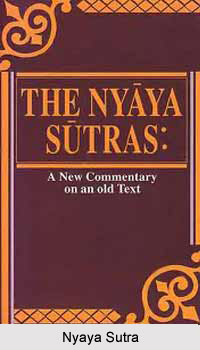 Perception in Nyaya Sutra is an awareness that stands in a special relation to its object. This relation is defined in purely non-cognitive terms. Further, it is also described in Nyaya Sutras that perception is a physical anchor between the subject and the external world. It is not itself cognitive; rather it supplies the raw material for knowledge and so for reason. Perception in Nyaya Sutra is considered as a rational activity. According to Buddhist philosophy, one does not perceive the object at all, but only patterns of colour, sound, touchy smell and taste. From their sequence in time and arrangement in space, one infers the presence of an object of one kind or another. Reason here is a mental faculty of construction, synthesis and super-imposition. It brings order to the array of sensory data.
Perception in Nyaya Sutra is an awareness that stands in a special relation to its object. This relation is defined in purely non-cognitive terms. Further, it is also described in Nyaya Sutras that perception is a physical anchor between the subject and the external world. It is not itself cognitive; rather it supplies the raw material for knowledge and so for reason. Perception in Nyaya Sutra is considered as a rational activity. According to Buddhist philosophy, one does not perceive the object at all, but only patterns of colour, sound, touchy smell and taste. From their sequence in time and arrangement in space, one infers the presence of an object of one kind or another. Reason here is a mental faculty of construction, synthesis and super-imposition. It brings order to the array of sensory data.
The early Naiyayika, however, has tied reason to explicit demonstration and proof. Since there is no logical relationship between the capacity to see an object and the capacity to describe it, one is led instead to the idea that objects enter directly into the content of perceptual experience. The Naiyayika also describes that if reason has a role in the construction or synthesis of the objects of perception, then realism about those objects is threatened. However, it is also believed that reason can have a role in the organisation of the totality of one`s perceptions. According to Nyaya Sutras, thought as judgement is either the perception of a passive unity of different data in substantive-adjective relation, or, going beyond perception, conscious management of data through actual use of language.
There are certain constraints on the physical relation that obtains between a perceiver`s perceptions and the object perceived. A first constraint is just that the relation be physical, so that it is not explicated in terms of semantic relations such as that of denotation. This is what is meant by the assertion that perception is `non-verbal`. Second, the relation has to have the right expansion and it needs to hold between perceptions and the sorts of object one is normally regarded as capable of perceiving. Moreover, Nyaya Sutra also attempts to give a physical description of perception. Vatsyayana points to cases of perceptual delusion and perceptual confusion. Perceiving with the eyes an object at a distance, a person cannot settle on whether it is smoke or dust. Such an indecisive awareness resulting from sense-object contact might be mistaken as perceptual at times. Buddhist objections to the Nyaya definition focus on instances where perception does seem to imply belief and inference. The Buddhist presses the Naiyayika on the point that there is, in perception, an inference and interpretation of what is immediately given.



















